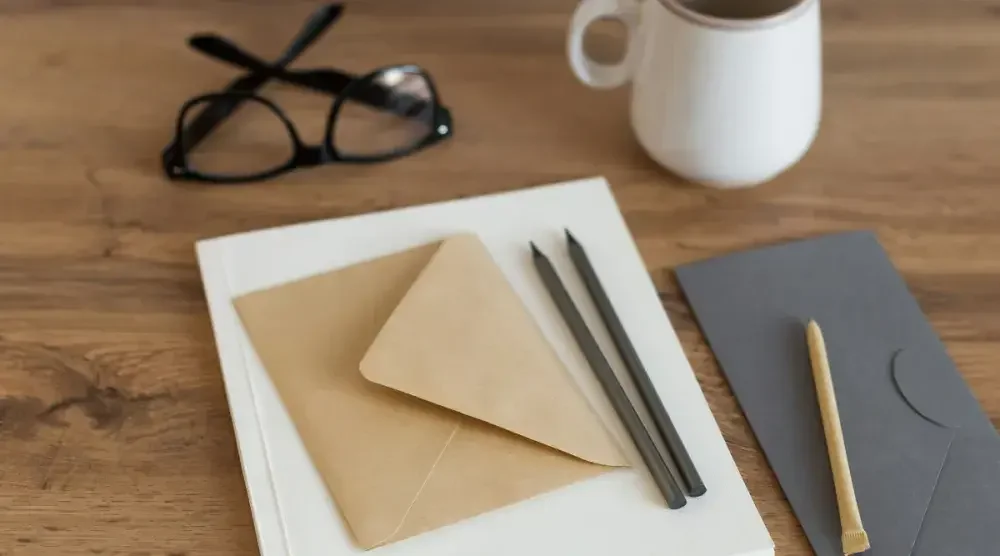In the age of email, there’s something formal and exciting about receiving a piece of physical mail. Using the postal system to mail something can be a personalized way to send something to a friend, to market to potential new customers, or to send something official, such as a business contract.
The United States Postal Service (USPS) processes and delivers over 300 million pieces of mail a day. The system is simple, reliable, and accurate.

How to mail a letter in 5 simple steps
In our digital age, we’ve all gotten used to sending off a quick email but have forgotten the simple pleasure of sending and receiving physical mail. These five steps will give you the knowledge you need in order to mail a letter.
Step 1: Choose the correct envelope
The first thing you need is the packaging for your letter. Envelopes can be used to send flat, flexible things. This might include letters, cards, stickers, checks, or anything else on paper.
The right envelope will depend upon what you want to send.
You can use a standard business-sized envelope, which holds a tri-folded 8.5-inch-by-11-inch piece or pieces of paper. Most business mail and formal documents are sent in this size envelope.
If you’re mailing a personal card, greeting card, or birthday card, you’ll need an envelope that fits that card. These come in a wide variety of sizes, but the card you purchase should come with an envelope.
If you need to send larger documents that can’t be folded, you can use an envelope that fits an unfolded 8.5 x 11 paper. Envelopes have a maximum size of 11-½-inches-by-6-⅛-inches high and can be no thicker than a quarter of an inch.
Choosing the correct size envelope can save you money in postage. A typical business envelope uses less postage than a larger envelope that might contain unfolded documents.
A $0.73 first-class mail Forever stamp can be used to send up to 1 ounce of material, which is about four sheets of standard-size paper.
If an envelope cannot bend or is lumpy, it will cost more because it will be treated as a package. Additionally, if the envelope has clasps, strings, or buttons, you may have to pay an additional cost.
Step 2: Insert and seal the letter
The next step in your process is to place the letter inside your envelope and then seal it.
You can put the paper in flat and unfolded or fold it. If you do fold the paper, it’s important to note that the envelope cannot be thicker than one-quarter of an inch. If it is, you could split it into multiple envelopes or pay the higher package price.
Once your paper is in the envelope, it’s time to seal it. Some envelopes have a sticky strip that needs to be wetted to activate. You can lick it or use a little water on your finger. Some envelopes have a pull tab that covers the sticky.
Once the sticky has been activated, press it down evenly from one side to the other to ensure a good seal.
If your envelope doesn’t have a sticky strip, you can close it by using tape or a glue stick.
Step 3: Address the envelope correctly
Once your letter is sealed inside the envelope, you need to address the envelope. This means writing your address, known as the return address, and the recipient's address, or where you want the letter to go.
The return or sender address is your address. This can be your home or business address. This goes in the top left corner of the envelope. This is included in case your letter cannot be delivered, and it must be returned to you.
The recipient's address, or where you want the letter to go, should be placed in the center of the envelope.
A U.S. address usually includes three separate lines of information. The top line will be the person or business's name, the middle line will be the street address and unit number (if there is one) and the bottom line will be the city, state, and ZIP code. International addresses and addresses to military bases may be longer than three lines.
It’s important to write clearly so the address is legible and will arrive at the correct place. The USPS prefers that names and addresses are written in all capital letters, but lowercase letters are acceptable so long as they are legible. Use a pen with dark ink and skip all punctuation: Commas and periods are not necessary.
Step 4: Calculate and attach postage
The final step before your letter can be mailed is to attach the correct amount of postage. The postage, or stamp, goes in the top right corner of the envelope.
The necessary postage is based on the weight and size of your letter. Most standard-sized letters (a personal card or business letter) only need a single Forever stamp, which costs 73 cents.
If your letter has more than four sheets of paper or is larger than a business envelope, you will likely need more postage. To calculate the necessary postage, you can weigh your letter at home using a food scale and purchase postage stamps online. You can also weigh and purchase postage at your local post office before mailing the letter. A postal worker can help you to weigh and apply postage if you’d like help.
You can purchase postage online through the USPS website or Stamps.com.
Step 5: Mail the letter
Now you’re ready to mail your letter. There are a few different ways to send your letter. You can:
- Place it in your personal mailbox at home, and a mail carrier will pick it up.
- Put it in a blue collection box. These can be found at the post office and sometimes around city centers.
If your letter is valuable or you want to know when someone receives it, you can pay extra to mail it using certified mail. You can choose to require a signature from the recipient and add insurance to the letter, which can reimburse you if it’s lost or damaged. This is known as registered mail with signature services.
USPS mail is generally delivered between one and five business days after it is sent. USPS delivers mail Monday through Saturday and delivers priority mail on Sundays.
USPS doesn’t deliver on these holidays:
- Jan. 1, New Year's Day.
- 3rd Monday of January, Martin Luther King, Jr. Day
- 3rd Monday of February, President's Day
- 4th Monday of May, Memorial Day
- July 4th, Independence Day
- 1st Monday of September, Labor Day
- 2nd Monday of October, Columbus Day
- Nov. 11, Veterans Day
- 4th Thursday of November, Thanksgiving Day
- Dec. 25, Christmas Day
How much does it cost to send a letter?
Other than your time to package and place the letter in a mailbox, the only cost to mail a letter is postage. The cost of postage will depend on the size, shape, and weight of your letter.
- Standard, one-ounce letter. The standard, one-ounce letter, which is most mail, will take a single Forever stamp, which currently costs $0.73. These stamps, once purchased, can be used forever. So, if you buy 10 in 2024 at 73 cents, you can continue using them for years to come, even when the price of stamps increases.
- Postcards. With a slightly different size, shape, and weight, postcard stamps cost $0.56.
- Oddly shaped letters. If your letter is bulky and oddly shaped, postage will start at $1.19.
- Large envelopes. If you’re mailing a large envelope, postage starts at $1.50. This category includes anything weighing over 3.5 ounces and under 13 ounces.
If you’re mailing letters for your business, the purchase of postage would be considered a tax-deductible business expense.
How to send a letter internationally
Sending a letter to another country is very similar to sending one within the United States, with a few minor changes.
You will package and address the letter the same as you would to send a letter to someone within your own state.
The difference is you’ll need to be certain that you’re correctly formatting the international address and will need to pay more for postage. The address should be written in English or include line-by-line translations.
Because the letter is traveling outside of the U.S., it will be more expensive. Postage for international mail starts at $1.65 for a one-ounce letter.
Before mailing something to another country, you might also want to make sure that you’re not including anything in that envelope that might be against the law to mail in that country.
Additional tips for sending letters
Before you send off your letter, be sure to review these additional tips for some expert-level advice. The USPS processes and delivers approximately 318 million pieces of mail each day, following these tips will ensure a smooth delivery.
- Your letter must be flexible. If it is rigid, it’s considered a package.
- Items that make the envelope lumpy could tear the envelope and get lost in transit.
- If your letter is valuable, you can add tracking or insurance.
- An embellished card should be inside a thick envelope to ensure it arrives intact.
FAQs
How long does it take to send a letter?
Once your letter has been placed in a mailbox with proper postage, it generally takes between one and five business days to be delivered to its final destination in the United States. International mail should be delivered within six to ten business days.
Can I send a letter without going to the post office?
Yes. If you already have the correct postage or can print it at home, you can mail letters without ever stepping foot inside a post office.
You can simply place your addressed and stamped envelope into your personal mailbox as outgoing mail or a blue collection box in a downtown area or outside of a post office.
What happens if I don’t have enough postage on my letter?
If your letter doesn’t have enough postage, it will be returned to the address you wrote in the top left corner of the envelope.
The letter will have been stamped “returned for additional postage.”
You can affix the additional needed postage, cross out the reason, and re-mail the letter.
What is the difference between first-class mail and priority mail?
USPS first-class mail is a way to send letters, thick envelopes, and packages. The mail must weigh under 13 ounces to be delivered using first-class mail. Typically, delivery takes one to five business days.
USPS priority mail is for larger packages. This service allows you to send up to 70 pounds across the United States. Priority mail can also be larger package sizes. Typically, delivery takes one to three business days.
Can I send a letter to a P.O. box?
Yes, you can mail a letter to a P.O. box. Be sure to include the P.O. box number in the address so that it can be delivered to the right place.

